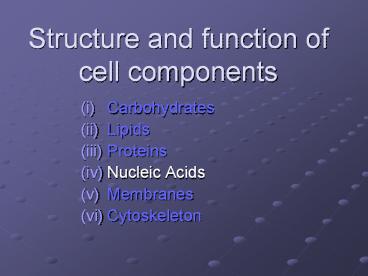Structure and function of cell components PowerPoint PPT Presentation
1 / 15
Title: Structure and function of cell components
1
Structure and function of cell components
- Carbohydrates
- Lipids
- Proteins
- Nucleic Acids
- Membranes
- Cytoskeleton
2
Revision
- What do we remember about the structure of DNA
and RNA from Higher?
3
Nucleotide structures
- The building block of a nucleic acid is a
nucleotide. - Nucleotides consist of
- A pentose sugar
- A nitrogenous base
- A phosphate group
4
Pentose Sugars
- Deoxyribose and ribose differ by the group
attachment at the 2C.
5
Bases
- There are 5 bases
- These can be classified into two types
- Purines
- Double ringed
- Adenine and Guanine
6
Bases cont
- Pyrimidines
- Single ringed
- Cytosine, Thymine and Uracil
7
Formation of a nucleotide
- A condensation reaction occurs between the OH
group on the 5 C and phosphate group to form a
strong phosphodiester bond. - A condensation reaction occurs between the base
and the 1 C to form a strong glycosidic bond
8
Formation of a nucleotide cont..
9
Formation of nucleic acid
- A phosphodiester bond also forms between the 3 C
and the phosphate group of the next nucleotide to
form the sugar phosphate backbone.
10
Base Pairing in DNA
- A and T join by two weak hydrogen bonds
- G and C join by three weak hydrogen bonds
11
DNA strands
- DNA strands are antiparallel
12
Revision
- What do we remember from Higher about replication
and transcription? - Both processes are controlled by enzymes. Where
do you think they need to be used and why? - DNA synthesis always proceeds in the direction 5
to 3. What problems does this cause and how
would you overcome these if you were designing a
cell.
13
Enzymes
- DNA polymerase
- Catalyses the linking together of DNA nucleotides
during replication - DNA polymerase can only add a nucleotide to the
3 end of the previous nucleotide. - RNA polymerase
- Catalyses the linking of RNA nucleotides during
transcription (and in the replication of the
lagging strand during DNA replication)
14
Enzymes cont
- DNA ligase
- Joins short sections of DNA together
- DNA replication animation
- http//207.207.4.198/pub/flash/24/menu.swf
15
Learning Activities
- Read DART pg 48 53 and take notes
- Scholar 4.5
- Nucleic Acids worksheet
- DNA replication worksheet
- Advanced Higher questions
- http//www.maxanim.com/genetics/index.htm
- Look at
- Replication fork
- DNA replication
- Meselson-Stahl experiment
- Make notes on DNA and RNA structure
- Make notes on replication and transcription
- Think about how you will remember which bases are
purines and which are pyrimidines - Write a summary of all the different bonds formed
between molecules by dehydration reactions.

